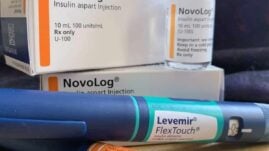This post may contain affiliate links. Please read our disclosure.
Traveling for work or pleasure — within one country or across the globe — is one of the most adventurous, memorable, educational, and fun experiences life has to offer.
For a person with diabetes, traveling can also be incredibly stressful, overwhelming, downright scary, and at times even dangerous.
Packing enough supplies, keeping your insulin safe from extreme temperatures, juggling insulin around new foods, dealing with blood sugar issues from jetlag and sleep deprivation, and trying to get everything that keeps you alive through every security checkpoint isn’t easy!
But we can’t let diabetes stop us from seeing the world — or from simply visiting your sister after she moves halfway across the country.
In this article, we’ll discuss need-to-know tips and precautions to take when traveling as a person with diabetes.

How to prepare for traveling with diabetes
While our non-diabetic family and friends can spontaneously hop on a flight to go skiing for 3 days at their uncle’s empty chalet in Vail, Colorado, those of us with diabetes could be putting a lot at risk in trade for spontaneity.
Here are a few crucial ways to prepare for any type of travel with diabetes:
Get extra insulin, pump supplies, test strips, and a new prescription.
What’s even more stressful than running out of insulin in the middle of Barcelona? Trying to get a prescription for more insulin in the middle of Barcelona.
So, if you’re traveling for more than just a day or two, ask your doctor for a prescription (on paper) for your insulin and test strips.
Some avid travelers will suggest you bring twice as much insulin as you expect you’ll need or an entire week’s worth of extra supplies. Others will suggest bringing at least one extra vial (or two pens) of every insulin and medication you’ll need.
Remember, on your way home, your entire flight might get canceled for two days because of a winter blizzard! Traveling means giving up control over many variables. Be prepared.
This means packing extra:
- Insulin
- Non-insulin injectable medications
- Oral medications
- Test strips
- Lancets
- Syringes or pen needles
- Batteries for your meter or pump
- Pump supplies
- CGM sensors
- Glucose tabs (for whenever food isn’t easily available)
The longer your trip is, the more imperative this is.
Three days in Colorado is a much different adventure than three weeks in London. But either scenario poses the risk of not getting home in time, eating far more carbs than usual, which means using your insulin and supplies more quickly, potential changes in your insulin needs because of altitude, stress, jet-lag, and being off your usual routine.
And when we’re in new situations, eating new foods, and often walking far more than usual, we tend to need to check our blood sugar more often to compensate for all of those variables. If you normally use 3 to 4 strips per day, you could easily wind up using 6 to 8 when you’re running around in the sunshine in Key West!
Also, remember, just because you eat low-carb at home and barely use 20 or 30 units of insulin per day doesn’t mean you won’t indulge in the local crepes, gelato, pizza, and lasagna while visiting Rome! Bringing enough insulin with you means having the freedom to explore and experience more of what your travels offer.
If you use an insulin pump…
It is imperative that pump users bring one or two vials or pens of long-acting insulin with them when they travel.
The moment your pump malfunctions or smashes on the floor during your awkward cruise-ship site change is the moment you will face life or death if you don’t have long-acting insulin with you.
You don’t know what will happen. Bring long-acting insulin no matter what! And make sure you talk to your doctor about what dose to take should you need to use it.
Get a doctor’s note.
The amount of pushback you could get at any type of security checkpoint (airports, train stations, museums, etc.) can vary significantly depending on the country, particular location, individual security guards, screening technology, recent events around the globe threatening public safety, etc.
Just because you’ve never had trouble passing a box of syringes, pump supplies, and vials of insulin through security in Chicago doesn’t mean it’ll be that easy in Paris, Tokyo, or San Diego.
To ensure all of your diabetes supplies stay with you, ask your primary care doctor for a printed and signed note with the medical office’s letterhead.
This note should state that you have type 1 or type 2 diabetes, any other significant medical conditions, and a clear list of the medical equipment and food you need to keep with you at all times to keep yourself healthy and alive.
Getting through TSA with your diabetes gear
You may also want to use that note to avoid being forced to walk through security screen technology like X-rays — or to avoid having your CGM or insulin pump put on the scanner.
It is your right to refuse walking through any security technology and to choose a “pat down” instead.
While the TSA claims this technology will have no ill effects on common diabetes gear, some are doubtful, and the manuals usually suggest you shouldn’t. If you don’t want to take the risk, be sure to have a doctor’s note handy so you can keep your lifesaving diabetes gear in your hands at all times.
You should also expect that TSA personnel will “wipe” any medication containers and devices with a product that helps them identify hazardous material (drugs, explosives, etc.). There’s no way around this, and there’s really no reason to worry about it harming your diabetes supplies.
These security checkpoints are designed to keep us all safer — so the more we can cooperate, the better. But don’t hesitate to speak up for yourself if you feel you or your diabetes needs and supplies are being disrespected.
Tip: People with diabetes are exempt from the 3.4 oz. liquid rule for medicines, fast-acting carbs like juice, and gel packs to keep insulin cool. However, not all TSA personnel will be aware of this so it’s best only to bring liquids if absolutely necessary.
Never pack your diabetes supplies in your suitcase or checked baggage.
This is important. Never ever put all of your diabetes supplies into the suitcase or bag you plan to check at the gate.
Here’s why:
They might lose your bag.
If the airline loses your bag completely, or it takes four days to get it back to you, you lose all of those supplies. Yikes! Enough said.
Temperatures will vary: extremely hot or extremely cold.
You have no idea what the temperature will be in any of the locations where those bags are stored. Too hot or too cold can easily destroy insulin, medication, test strips, sensors, or the adhesive of your infusion set. Keep these items with you at all times!
Speaking of extreme temperatures, consider getting a Frio pack if you know you’re traveling somewhere really hot. Frio packs are activated by dipping them in water and will protect the temperature environment of your insulin. They vary in size and price! (And remember, do not leave your diabetes supplies in a very hot or cold car! Ever!)
You can learn more about how to keep insulin cool and what products you can use in our guide to the best portable insulin fridges.
People steal.
It may not happen often, but it does happen. Bags are unzipped, rifled through, and quickly tossed aside. Either they take your valuable-looking bag of medical goods, or it gets carelessly thrown into a dark corner. Either way, no good!
Food to treat lows may be hard to find.
You cannot expect to always be able to buy food to treat low blood sugar. Keeping a full container of glucose tabs with you while traveling ensures you’ll never struggle to adequately treat a low. (Ever had a low in the middle of the night while staying in a hotel room? Trying to search for quarters to buy something in the vending machine with a 50 mg/dL? Not fun.)
Pack your diabetes supplies in your carry-on and keep it with you at all times. Treat that bag like it’s your newborn baby. Don’t put your baby on the X-ray belt, don’t let other people look it over without your consent and close observation, and do not put your baby in a suitcase and hand it off to total strangers!
Find your medical ID
Can you remember the last time you wore a medical ID? I’m not very good at wearing mine either, but when traveling and surrounded by people who don’t know you, it could be lifesaving. Get one if you don’t have one. Wear one if you do!
You can get a great medical ID for diabetes at Lauren’s Hope.
Get travel insurance
Local healthcare rules and costs vary greatly from country to country. Always make sure that you are covered in case you have to use the local healthcare system.
Bring your own food for the plane, train, or bus.
Airports are certainly trying harder these days to offer healthier things, but paying $12 for a pre-packaged salad seems a bit silly. And let’s be honest, that salad isn’t going to be especially fresh or flavorful.
Here are 5 tips when it comes to nutrition while traveling:
Pack a variety of Ziplock bags with things like nuts, crackers, carrots, an apple, roasted chickpeas, rice cake with peanut butter, and a few of your favorite protein bars. Airport security will always let well-contained food items through the checkpoint. Just remember that you cannot bring liquids, and you’ll likely need to spend $7 on a bottle of water once you’re past the TSA screening.
Don’t fall for mindless eating or stress-eating just because you’re traveling. Traveling can be stressful and/or quite boring. It’s easy to mindlessly entertain yourself with food. Start your travels with the intention that you will not use food as a distraction or comfort today — there are far too many junk-food temptations in an airport.
Get up and walk around instead. You don’t have to sit there twiddling with your phone and resisting the urge to eat a giant bag of M&M’s. Get up and walk! Airports are great for walking. If you have a lot of bags with you, this could be tricky, but if not, take advantage of the opportunity to move before being stuck on the airplane for the next 4 hours.
Use the day to practice intermittent fasting. Air-travel days are a great opportunity for a long day of fasting. You’ll still need to check your blood sugar often, and you’ll likely need a unit of fast-acting insulin here or there to compensate for your liver’s glycogen output since you’re not eating. Otherwise, fasting can eliminate most of the stress around trying to eat healthy while traveling.
*Read more about intermittent fasting with diabetes.
If you do eat at an airport restaurant…be smart and creative when ordering your food. If you want to use a day at the airport as an excuse to treat yourself to a giant Wendy’s chocolate shake, that’s totally up to you. If you’d like to avoid that kind of option, be specific with adjustments like “swap the rice for lettuce” at Mexican places, throw out the bun and just eat the burger patty, get a salad with steak instead of the steak and potatoes, etc. You have control over what ends up on your plate and what ends up in your mouth. Use that power for your own good!
How traveling with diabetes can cause abnormal high and low blood sugars
When traveling somewhere across the country or to another country, it’s very possible you’ll need more insulin than usual. Don’t freak out! This isn’t necessarily a bad thing, it’s just your body adjusting to things like a different altitude, timezone, activity level, food, and dehydration.
Let’s take a closer look at these variables.
High Altitudes
If you live somewhere that isn’t particularly well-known for its mountains and skiing options, you likely live in a lower altitude. If you then spend a week in the Rocky Mountains, Nepal, or even just Boulder, Colorado, you’re going to see your blood sugars rise.
The only way to manage this is by increasing your background insulin dose via your pump settings or long-acting insulin dose.
Oddly enough, your body actually doesn’t break down and metabolize carbohydrates as efficiently when living in a high altitude part of the globe, and you’ll experience overall increased insulin resistance. Talk to your healthcare team about potentially making a 20 percent (or more) increase in your background insulin dose prior to your trip.
Tip: Most blood sugar meters will actually show lower values at higher altitudes, including when flying. This is because they use glucose-oxygenase methods, which are dependent on oxygen in the surrounding environment (and there is less oxygen the higher you go). Be aware that your meter may show values that are as much as 10-15% lower than reality when flying.
Timezones (jet lag and sleep deprivation)
Suddenly telling your body to operate as though it’s 3 hours earlier than usual is not an easy request if you take insulin. You may notice some degree of insulin resistance because of increased cortisol and your body’s overall struggle to adapt for a day or two to this new schedule.
If the changes in timezone have also left you reasonably sleep-deprived, you might notice higher blood sugars and insulin resistance because of increased cortisol. This is a normal part of the human body that we simply have to manage as people with diabetes.
Jetlag can be pretty tedious if you have diabetes. The best way to help compensate for it is to take a nap as soon as you can. Catching up on sleep will reduce cortisol levels quickly.
If you use a pump, your healthcare team will likely suggest you simply change the time on your pump to the timezone you’ve traveled to.
If you take long-acting insulin, you’ll likely want to add or subtract the time of day and take your injection at that new time for the remainder of your trip. Or you can take your long-acting somewhere in the middle of your old timezone and your new timezone. Talk to your healthcare team to determine what’s right for your body and medication regimen.
If you’re only going to be in that new timezone for a day or two, you may find it easier to not change anything. Regardless, check your blood sugar often during transitions like this!
Activity level
Big changes in your activity level while traveling is expected. If you’re on a cruise ship, sitting by the pool and drinking Pina Coladas all afternoon, you can expect to need an increase in both your background and meal insulin doses.
If you’re backpacking through Europe, you’ll probably experience a lot of lows if you don’t quickly reduce your background insulin doses.
What if you’re traveling to Denver, Colorado, where the altitude will likely call for more insulin, but you’re going to be hiking for 5 hours every day? This can get tricky. Sometimes you’ll have to wait and see how things go for the first day or two before making any changes at all.
Check your blood sugar often, and approach changes in your insulin dose carefully, never making more than a total of 1 to 3 units increase or decrease in one day unless otherwise instructed by your doctor.
Food
Part of the joy and experience of traveling is the immersion into another culture — and that definitely includes trying that culture’s unique foods! Maybe it’s a Nutella crepe in France, fresh naan bread in India, or the freshest sushi you’ve ever tasted in Japan.
Just because you have diabetes doesn’t mean you can’t try to enjoy new foods. Depending on how you manage diabetes (insulin, oral medications, or diet alone), you may have to set clear limits on how many high-carb foods you try in one day.
Remember, if the food you’re eating is both high-carb and high-fat, it will likely digest very slowly, which means you’ll need to take some insulin when you’re eating and another large dose a few hours after eating. (Or you’ll use the Square or Wave bolus features on your pump.)
Also, if you’re eating more carbohydrates overall, don’t be surprised if you need an increase in your background insulin doses. Even a bump of 1 or 2 units total over the course of your day can help compensate for the extra glucose in your bloodstream from all those extra carbs.
You can also ask for a small refrigerator in your hotel room to help store healthier items from the grocery store, so you have easy-to-grab options you’re familiar with.
Remember, if you’re traveling to a more rural part of the country, ask before assuming that any tap water is safe to drink!
Regardless, check your blood sugar often, adjust as needed, and don’t beat yourself up for not getting it right the first time. New foods are never easy for a person with diabetes — especially if you take insulin. Do the best you can, keep yourself safe, and enjoy your trip!
Dehydration
It is very easy to get dehydrated while traveling or while visiting a new place. You’re busy, doing new things, and likely not consuming as much water as usual.
But even mild dehydration can have a pretty big impact on your blood sugar levels because the less water there is in your tissues and bloodstream, the more concentrated the glucose in your blood becomes.
Dehydration can result from a variety of factors while traveling, including:
- Hot, humid climate (which can also burn glucose more quickly)
- Hot, dry weather
- Not drinking enough fluid during the day
- Eating foods high in sodium
- Excessive sweating
- Alcohol consumption (hello, cruise boat)
- Air travel
- Mental/emotional stress
- High Altitudes
- Food poisoning (get yourself to an ER immediately)
- Repeated vomiting (whether it’s a stomach bug or food poisoning, people with diabetes should visit an ER to get intravenous fluids to prevent severe dehydration)
Getting enough water in your day as a person with diabetes is extremely important. Make it a priority while traveling to spare yourself further blood sugar management struggles.
Managing a medical emergency while traveling with diabetes
While we’d like to think everything will go smoothly, traveling always comes with a variety of unpredictable events you can’t always control — and some of those include genuine medical emergencies.
If it’s a country with a foreign language you don’t speak…
The American Diabetes Association recommends getting this list of English-speaking foreign doctors from the International Association for Medical Assistance to Travelers or calling 716-754-4883 for assistance during emergencies.
“If an emergency occurs while you’re traveling and you don’t have such a list,” advises the ADA, “contact the American Consulate, American Express, or local medical schools for a list of doctors.”
A stomach virus or food poisoning
If you have diabetes and are vomiting repeatedly, you must go to an ER to get intravenous fluids. There’s truly no way around this. If you can’t keep fluids down, you’re going to get severely dehydrated while your body fights that virus or works out that bad food.
Severe dehydration in a person with diabetes can lead to Diabetic Ketoacidosis, which can be fatal. Getting to the hospital sooner rather than later means you’ll likely only be there for a few hours. Waiting until things are really bad means you’ll be there for at least 24 hours or longer. Don’t wait. If you’re puking, get to the hospital or urgent care clinic.
If you’ve chosen to travel to a very rural location where this kind of care isn’t possible, you’re taking on the risk of fatality as a person with diabetes. Does that mean you shouldn’t go? Not necessarily, but definitely talk to your healthcare team about these kinds of events and how you can best prepare for and manage them.
Running out of insulin
Running out of insulin or other diabetes supplies while traveling is a very scary thing. That’s why it’s so important to pack extra supplies for all types of travel.
If you do find yourself in this unfortunate position, there are a few things to keep in mind:
Not all insulin is U-100. In the USA, we generally use U-100 unless you’re dealing with severe insulin resistance and use a stronger concentration. If you’re getting insulin in an ER or pharmacy overseas, do not assume it’s U-100. Do your best to communicate with the person administering your insulin and read the fine print carefully on any insulin you’re purchasing.
Use Facebook, Twitter, Instagram to help you get extra supplies if you need them. I’ve seen countless posts on Facebook of a person with diabetes in need of test strips or insulin while traveling, posting about it on social media, and getting what they need through the grapevine world of people with diabetes! Don’t be afraid to ask for help!
Traveling with diabetes can be done! Don’t let diabetes keep you stuck at home — but if you do travel, be smart by preparing for the many variables and challenges that come with managing this disease.





Gary Kunselman
Question about the victoza med for once-a-day administering for lowering blood sugar and time zones with insulin for PM.? 3 hours earlier in new zone – body used to 6:00 A.M. for victoza and 9:00 P.M. for boost of insulin – how would you manage that?
Christel Oerum
When I travel 3 time zones or less I just switch to the destination time when I get there and take my insulin at the same time. But you should consult with your doctor as she/he knows your history and medication needs
Petrina
I’m traveling for the first time to California from Michigan. It’s a 3 hour difference. I’m very nervous about the time difference, but reading this article has helped me more than you know. Thank you so much
Antonio De Luca
Christel, awesome and comprehensive topic. I took notes of the things I didn’t know or practice.
In my case changing the time of my pump depends if I am flying East or West and the time my insulin resistance changes to a low BG profile.
Thanks for sharing these great educational docs.
Regards.